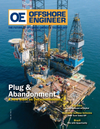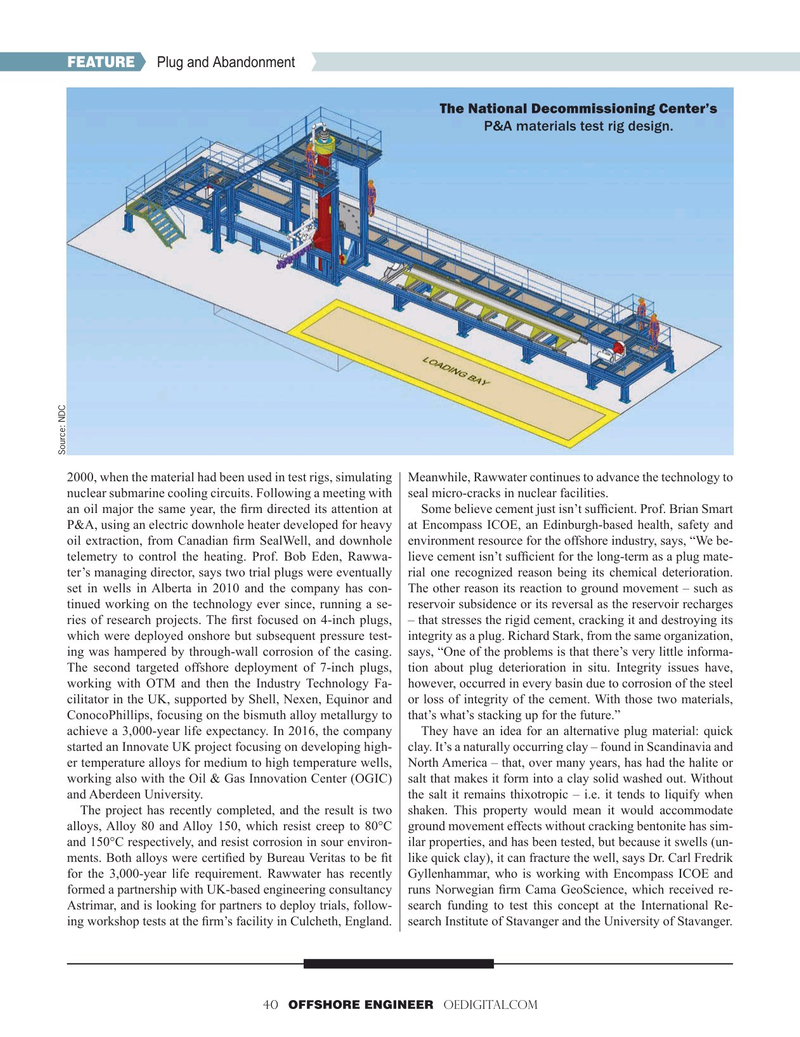
Page 40: of Offshore Engineer Magazine (Sep/Oct 2019)
Big Data and Digitalization
Read this page in Pdf, Flash or Html5 edition of Sep/Oct 2019 Offshore Engineer Magazine
FEATURE Plug and Abandonment
The National Decommissioning Center’s
P&A materials test rig design.
Source: NDC 2000, when the material had been used in test rigs, simulating Meanwhile, Rawwater continues to advance the technology to nuclear submarine cooling circuits. Following a meeting with seal micro-cracks in nuclear facilities.
an oil major the same year, the ? rm directed its attention at Some believe cement just isn’t suf? cient. Prof. Brian Smart
P&A, using an electric downhole heater developed for heavy at Encompass ICOE, an Edinburgh-based health, safety and oil extraction, from Canadian ? rm SealWell, and downhole environment resource for the offshore industry, says, “We be- telemetry to control the heating. Prof. Bob Eden, Rawwa- lieve cement isn’t suf? cient for the long-term as a plug mate- ter’s managing director, says two trial plugs were eventually rial one recognized reason being its chemical deterioration. set in wells in Alberta in 2010 and the company has con- The other reason its reaction to ground movement – such as tinued working on the technology ever since, running a se- reservoir subsidence or its reversal as the reservoir recharges ries of research projects. The ? rst focused on 4-inch plugs, – that stresses the rigid cement, cracking it and destroying its which were deployed onshore but subsequent pressure test- integrity as a plug. Richard Stark, from the same organization, ing was hampered by through-wall corrosion of the casing. says, “One of the problems is that there’s very little informa-
The second targeted offshore deployment of 7-inch plugs, tion about plug deterioration in situ. Integrity issues have, working with OTM and then the Industry Technology Fa- however, occurred in every basin due to corrosion of the steel cilitator in the UK, supported by Shell, Nexen, Equinor and or loss of integrity of the cement. With those two materials,
ConocoPhillips, focusing on the bismuth alloy metallurgy to that’s what’s stacking up for the future.” achieve a 3,000-year life expectancy. In 2016, the company They have an idea for an alternative plug material: quick started an Innovate UK project focusing on developing high- clay. It’s a naturally occurring clay – found in Scandinavia and er temperature alloys for medium to high temperature wells, North America – that, over many years, has had the halite or working also with the Oil & Gas Innovation Center (OGIC) salt that makes it form into a clay solid washed out. Without and Aberdeen University. the salt it remains thixotropic – i.e. it tends to liquify when
The project has recently completed, and the result is two shaken. This property would mean it would accommodate alloys, Alloy 80 and Alloy 150, which resist creep to 80°C ground movement effects without cracking bentonite has sim- and 150°C respectively, and resist corrosion in sour environ- ilar properties, and has been tested, but because it swells (un- ments. Both alloys were certi? ed by Bureau Veritas to be ? t like quick clay), it can fracture the well, says Dr. Carl Fredrik for the 3,000-year life requirement. Rawwater has recently Gyllenhammar, who is working with Encompass ICOE and formed a partnership with UK-based engineering consultancy runs Norwegian ? rm Cama GeoScience, which received re-
Astrimar, and is looking for partners to deploy trials, follow- search funding to test this concept at the International Re- ing workshop tests at the ? rm’s facility in Culcheth, England. search Institute of Stavanger and the University of Stavanger.
40 OFFSHORE ENGINEER OEDIGITAL.COM

 39
39

 41
41